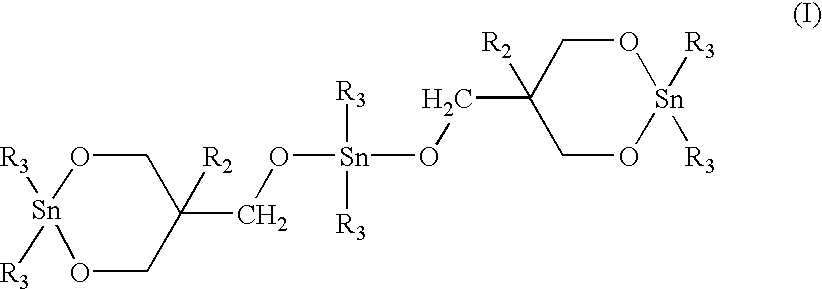Macrocyclic polyester oligomers and processes for polymerizing the same
a technology of polyester oligomers and macrocyclic polyester, applied in the direction of tin organic compounds, group 4/14 element organic compounds, synthetic resin layered products, etc., can solve the problems of limited development of processing equipment for use limited application of macrocyclic polyester oligomers, and time-consuming and expensive modification of existing equipmen
- Summary
- Abstract
- Description
- Claims
- Application Information
AI Technical Summary
Problems solved by technology
Method used
Image
Examples
example a
The macrocyclic polyester oligomers used in the following example are macrocyclic copolyester oligomers with 95.0 mol % of PBT and 5.0 mol % of PET. The macrocyclic copolyester oligomers were prepared by heating a mixture of copolyester linears, organic solvents, such as o-xylene and o-dichlorobenzene, which are substantially free of oxygen and water, and tin or titanium compounds as transesterification catalysts.
A clean stainless steel reactor equipped with a magnetically coupled stirrer and heater with controls was charged with 4800 ml (4176 grams) of o-xylene, 59.2 grams (0.269 moles) of PBT pellets and 2.72 grams (0.0142 moles) of PET pellets to produce a 0.06 M polymer / o-xylene solution. The solution was heated to 100.degree. C. and sparged with dry nitrogen until the moisture content of water was about 5 ppm. Sparging also removed the dissolved oxygen in the solvent and inerted the reactor. The reactor was then sealed. The mixture was heated to 220.degree. C. After the tempera...
example 1
Twenty milligrams of 1,1,6,6-tetra-n-butyl-1,6-distanna-2,5,7,10-tetraoxacyclodecane ("stannoxane-1") was dissolved with heating in approximately 2.5 ml of toluene which had been pre-dried by treating with 4A molecular sieves. The solution was cooled and poured into a glass jar containing 5.0 g of finely pulverized macrocyclic copolyester oligomer of PBT / PE (95 / 5 molar ratio). After intimately mixing the resulting uniform paste was dried under vacuum at about 50.degree. C. The white crusty solid was pulverized by using a pestle and a mortar. The resulting uniform free flowing white powder contained 0.3 mole % of tin atoms per mole of the copolyester monomer repeat units.
example 2
Example 1 was repeated except that 33.0 mg of stannoxane-1 catalyst was employed to give a blend containing 0.5 mole % of tin atoms per mole of the copolyester monomer repeat units.
PUM
| Property | Measurement | Unit |
|---|---|---|
| temperature | aaaaa | aaaaa |
| temperature | aaaaa | aaaaa |
| temperature | aaaaa | aaaaa |
Abstract
Description
Claims
Application Information
 Login to View More
Login to View More - R&D
- Intellectual Property
- Life Sciences
- Materials
- Tech Scout
- Unparalleled Data Quality
- Higher Quality Content
- 60% Fewer Hallucinations
Browse by: Latest US Patents, China's latest patents, Technical Efficacy Thesaurus, Application Domain, Technology Topic, Popular Technical Reports.
© 2025 PatSnap. All rights reserved.Legal|Privacy policy|Modern Slavery Act Transparency Statement|Sitemap|About US| Contact US: help@patsnap.com



